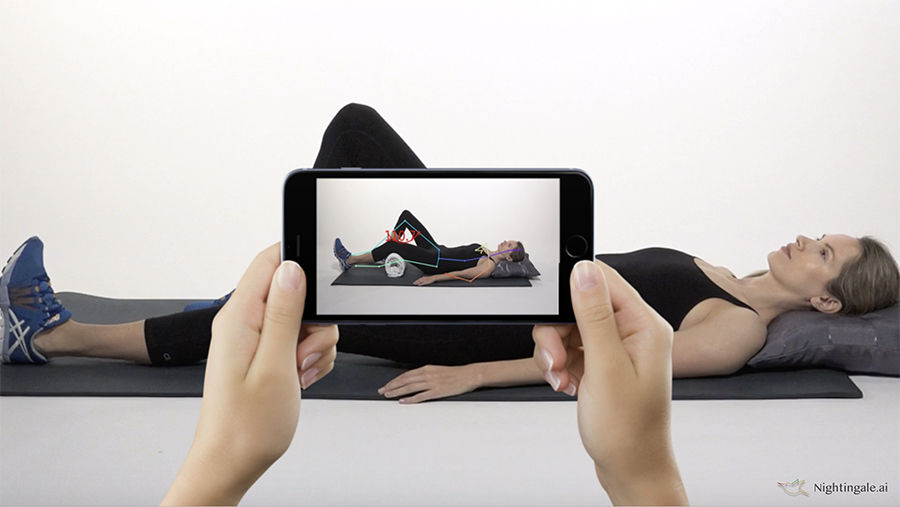From crowdsourcing new treatments for rare diseases to catalyzing the work of urban planners, five worthy ideas are one step closer to commercial viability after Hatchery Demo Day 2021, held virtually throughout the week of September 13 – 17, 2021.
A total of 17 teams competed in the Hatchery NEST process, an experiential learning opportunity that instills and nurtures an entrepreneurial mindset in participating U of T students and faculty.
Over the summer, participants met potential co-founders, developed their business plans and got connected with mentors who offered support in various areas, including market research, branding and securing intellectual property. The program culminated on Demo Day, with teams pitching their startup ideas to a panel of judges, including entrepreneurs and investors, some of whom are themselves former Hatchery participants.
The five winning teams will share $80,000 in seed funding, which will help take their companies through the next phase of their development.
“Hatchery Demo Day is my favourite way to kick off a new academic year,” says Chris Yip, Dean, U of T Engineering. “I’m always impressed by the creativity, the professionalism and the energy of these dynamic students, and I look forward to watching them grow in the years to come. On behalf of the Faculty, congratulations to all the teams that participated this year, as well as to Joseph Orozco and his whole team at The Hatchery for making this possible.”
This year’s winning teams are:
Civvic – AI-enabled web platform for developers and urban planners
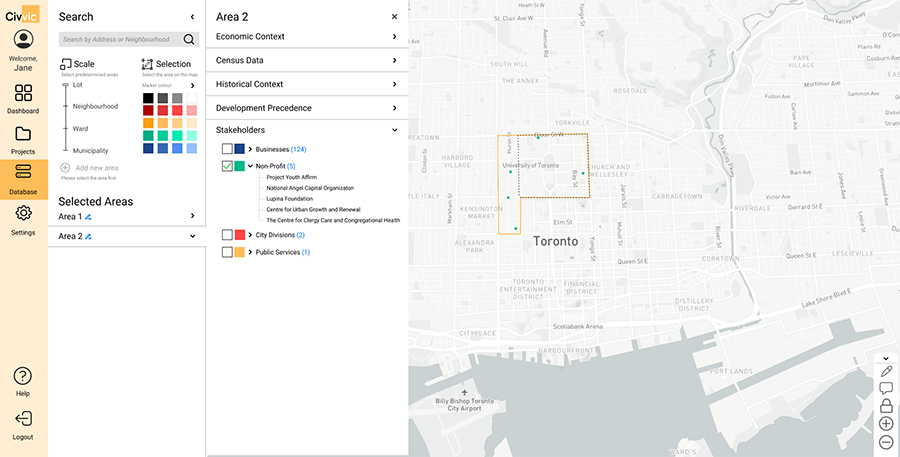
Planning a new urban development is complex. It requires assembling information about the historical, social and economic attributes of a particular site or neighbourhood, plus liaising with a wide range of stakeholders. Civvic aims to streamline the research process by bringing all of this information together in a single platform.
“The process of getting ready for Demo Day has been one of the most challenging, yet rewarding activities our team has faced,” says Lewis Walker, CEO of Civvic, who recently graduated from U of T’s Departments of Human Geography and Planning & Urban Studies.
“We realized that there’s often a gap in what we think is going on versus what is actually happening out in the field. Being willing to learn and able to pivot on the go has been critical for our team.”
Civvic plans to continue development of its online platform through the end of 2021 and is looking to hire new members for its team.
In addition to Walker, Civvic includes recent U of T graduates Michelle Zhang (Urban Studies, Peace, Conflict and Justice, Human Geography); David de Paiva (Urban Studies, Political Science); Ian Hwang (Human Geography, Urban Studies); Khaled Elemam (Bioinformatics and Computational Biology) and Patrick Thang (Rotman Commerce).
Fovea — Wearable sensors for people living with blindness
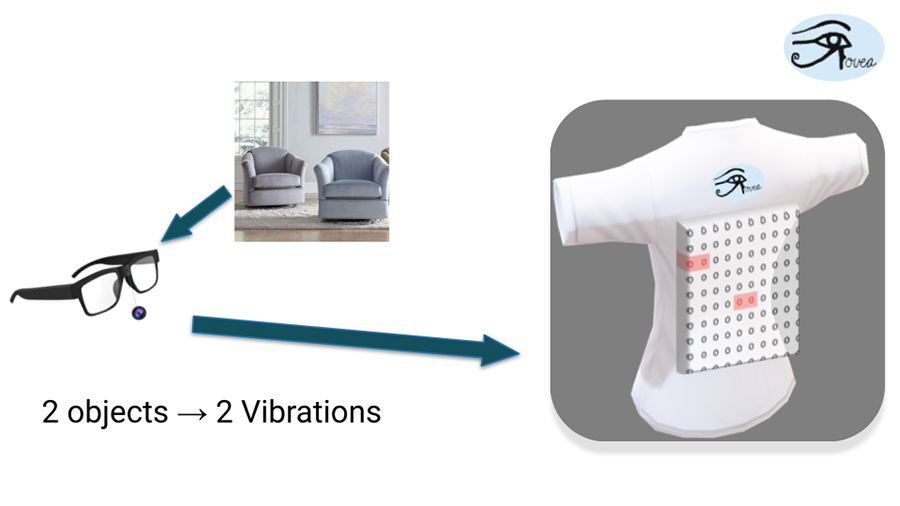
Fovea aims to help people who are blind by translating visual information into tactile signals relayed via a wearable vest.
Embedded within the vest is an array of 100 coin-sized motors, each of which is capable of vibrating based on input from a wearable camera. The system can provide certain basic information upon entering a room: how many objects are there, and roughly how far away they are.
“We provide an alternative to photonic-based sight in order to allow blind people to neuro-spatially sense their surroundings, better orient themselves and become more independent,” says Alaa Shamandy, a machine learning researcher at UHN’s Peter Munk Cardiac Centre and a member of Fovea. “With our non-invasive technology, we are working towards a more accessible world.”
Shamandy says the team has developed a rudimentary prototype of the device. They will use the funding from The Hatchery to develop a second version and facilitate volunteer testing by individuals with blindness. They also plan to apply for premarket approval from regulatory agencies, such as the U.S. Food and Drug Administration and Health Canada.
“The Hatchery has been extremely helpful throughout our development, from weekly pitching in front of distinguished mentors and investors to helping us perfect our business models and cash flows — and everything in between. We are in a much better place than when we started.”
In addition to Shamandy, Fovea includes: Spandana Chintapalli, a PhD candidate in Biomedical Engineering at University of Pennsylvania, Philadelphia; and Kevin Fan, an Emergency Resident Physician at Aventura Hospital in Miami, Fla. The company is also looking at expanding its team in Toronto.
Learn more about Fovea in this short video
Nightingale AI — Improving physiotherapy with vision-based AI tools
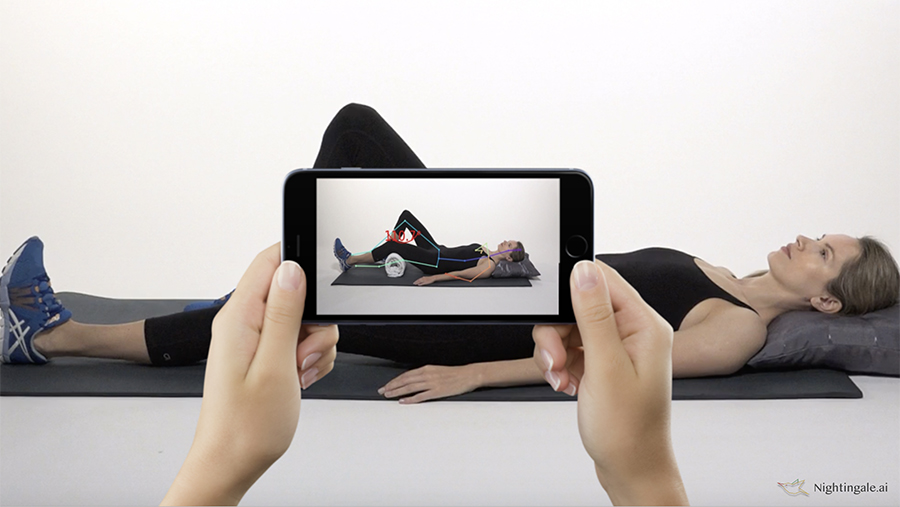
Nightingale.ai is an online platform that can be used by physiotherapists and their patients who are rehabilitating following knee or hip replacement surgeries. It uses vision-based AI to detect and analyze the same kinds of parameters that physiotherapists look for during in-person visits, such as how the surgical incision looks, how the patient is walking and how the new joint is moving.
Read more about Nightingale.ai in this story from the Lawrence S. Bloomberg Faculty of Nursing
Using this information, the platform can recommend a treatment plan or schedule in-person appointments as needed. By facilitating more frequent interaction and a better exchange between physiotherapists and their patients, Nightingale.ai can improve outcomes while lowering the cost of care. It also provides rich data on recovery outcomes that can be used to further optimize care for future patients.
“As a group of clinicians, engineers and researchers who have worked in the physiotherapy field for many years, we are very familiar with the problems encountered by both patients and providers during the rehabilitation journey,” says Sameer Chunara, CEO of Nightingale.ai and an Advanced Practice Physiotherapist and owner of an community clinic in Toronto.
“We have been surrounded by a team of advisors who have helped us focus on what is really important at this stage.”
The team plans to use the funding they received to augment their core team of engineers and continue developing and testing their platform. They hope to have a beta version in the next six months.
In addition to Chunara, Nightingale.ai includes: Donovan Cooper, Manager of Site Operations at Altum Health; Professor Charlene Chu (Lawrence S. Bloomberg Faculty of Nursing); Meng-Fen Tsai (BME PhD candidate), and Chao Bian (BME PhD candidate).
Learn more about Nightingale.ai by watching this short video
ParkinSense – Medical monitoring system for people living with Parkinson’s disease
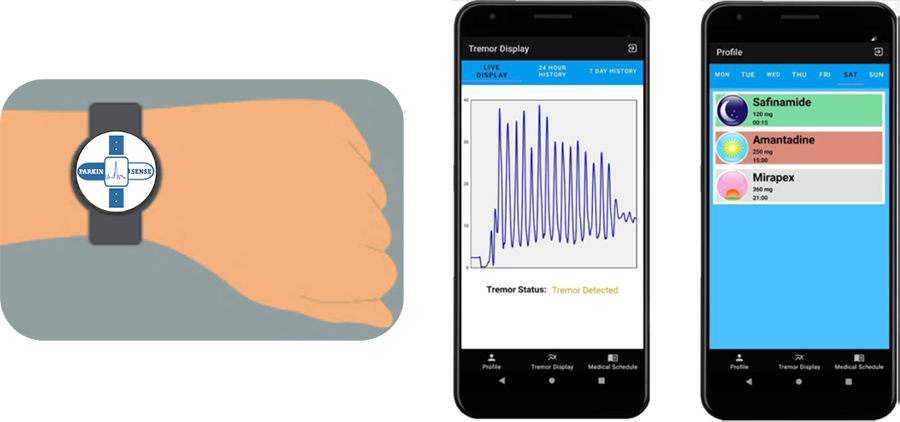
Parkinson’s disease is a neurological disorder that affects more than 100,000 people in Canada alone. One common symptom of the condition is a tremor, an involuntary quivering movement or shaking of the hand, leg or foot.
ParkinSense is creating a monitoring system that can provide continuous, real-time data about tremors that can expedite the treatment of Parkinson’s patients by enabling more effective interactions with their physicians. It’s also providing a mobile application that can remind patients when it’s time to take their medications, as well as to track their effectiveness over time.
“Having like-minded, passionate people who wanted to see us succeed made the start of our journey very meaningful to us,” says Dr. Carolina Gorodetsky, a pediatric neurologist and movement disorder specialist at SickKids Hospital. “The funding will help out with our prototyping and volunteer testing plans so that we can refine our product and launch it in the near future.”
In addition to Gorodetsky, ParkinSense also includes Akshata Puranik (UTIAS MEng candidate) and Christopher Lucasius (ECE PhD Candidate).
Learn more about ParkinSense in this short video
Varient — Crowdsourcing treatment efficacy data for rare diseases
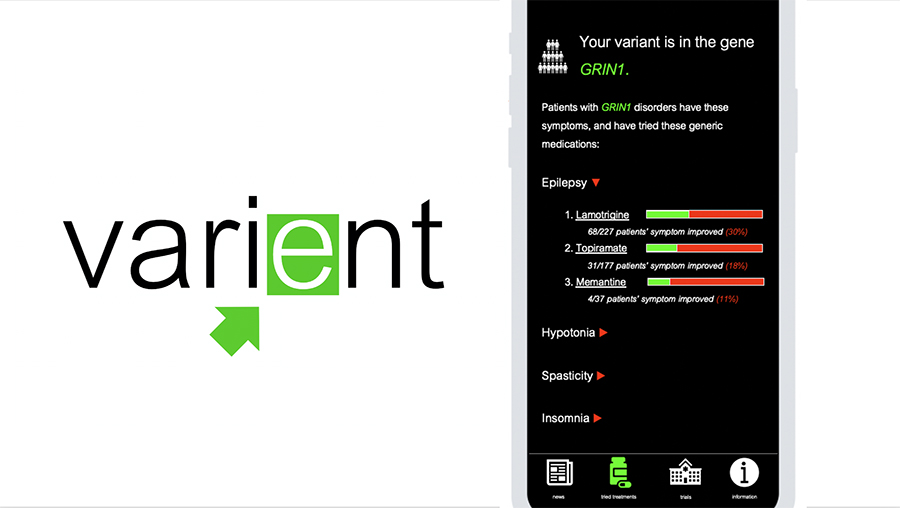
People suffering from rare diseases often resort to off-label use of existing drugs in a search for an effective treatment. However, this is currently done in an undocumented way, and resulting data on whether or not the treatment is actually effective gets lost.
Varient aims to change this via crowdsourcing. The team has built an online platform that can collect and aggregate de-identified data on treatment effectiveness from groups of people who are all living with the same rare genetic condition or disease. The goal is to take the guesswork out of the process, pointing the way toward drugs that are most likely to be effective.
“Typically, rare disease patients rely on word-of-mouth avenues to learn about helpful off-label medicines,” says Katheron Intson, a PhD candidate in Pharmacology at the Temerty Faculty of Medicine. “We can quantify the success of tried treatments and become a dynamic information provider to these populations.”
The team plans to use the funding to do comprehensive testing of their alpha product, with a goal of launching in 2022. Intson says that The Hatchery provided a valuable bridge between technology and business.
“I’ve been a scientist for my entire professional life, and the rest of my team are software developers,” she says. “The business aspect of starting a company was a real blind spot to us. The Hatchery provided us with guidelines that helped us redefine where we focused our energy and effort.”
In addition to Intson, Varient includes: Chen Zong Lu (Computer Science); Zuoqi Wang (Computer Science); Jingyi Sun (Computer Science), Shukui Chen (Applied Mathematics); Yexiong Xu (Computer Science); and Siyang Liu (Computer Science)

